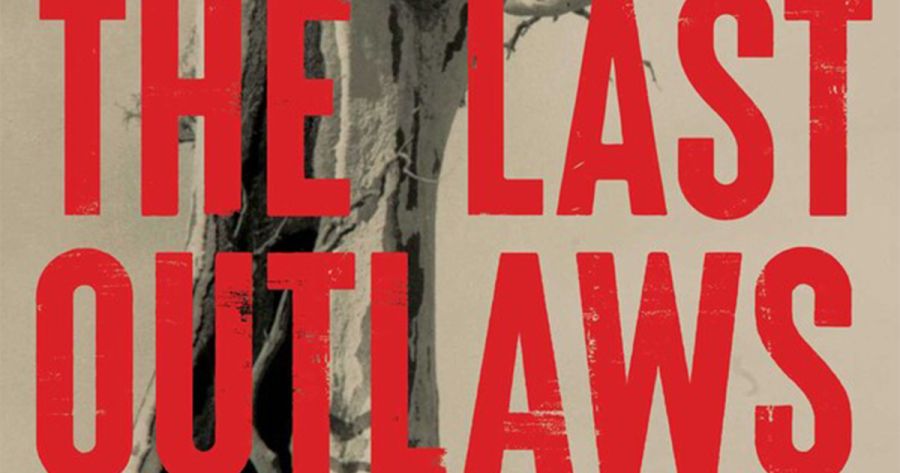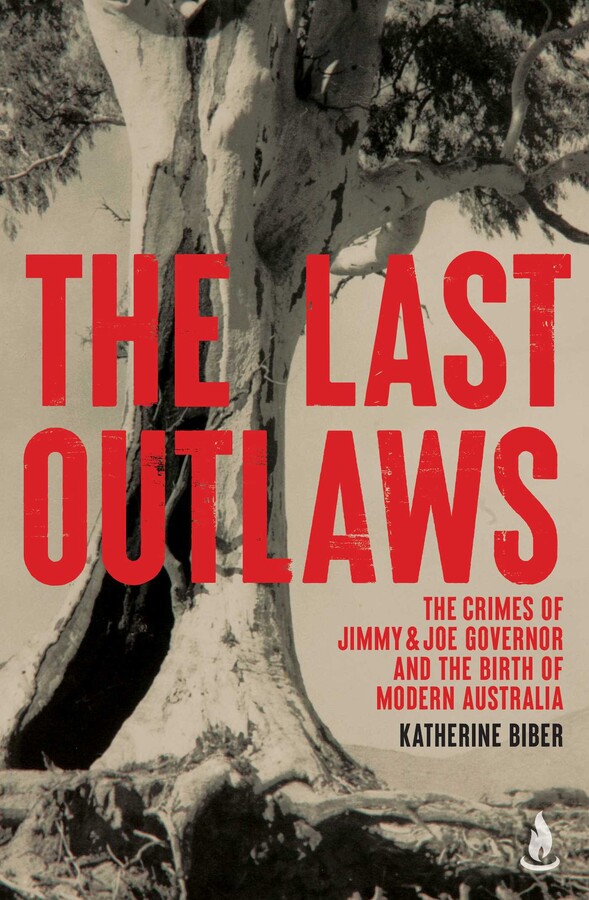
- Free Article: No
- Contents Category: History
- Review Article: Yes
- Article Title: Story of archive
- Article Subtitle: The afterlife of evidence
- Online Only: No
- Custom Highlight Text:
The fence post was wrapped in old newspaper and kept in the shed. It was all that Aunty Loretta Parsley, Jimmy Governor’s great-granddaughter, had left to touch of his life. ‘His hands touching that,’ she told Katherine Biber, ‘that’s why I asked you to open it. Because you need to connect with this story.’ Overwhelmed, Biber felt the ‘immense responsibility’ entrusted to her.
- Book 1 Title: The Last Outlaws
- Book 1 Subtitle: The crimes of Jimmy and Joe Governor and the birth of modern Australia
- Book 1 Biblio: Simon & Schuster, $36.99 pb, 336 pp
- Book 1 Cover Small (400 x 600):

- Book 1 Cover (800 x 1200):

- Book 1 Readings Link: https://www.readings.com.au/product/9781761631665/the-last-outlaws--katherine-biber--2025--9781761631665#rac:jokjjzr6ly9m
In the winter of 1900, Jimmy Governor, a twenty-five-year-old Wiradjuri/Wonnarua man, was building fences with his brother Joe and their friend Jacky Underwood, on a rural property at Breelong, 75 km north of Dubbo in central New South Wales. When Jimmy showed the posts he had cut to his employer, John Mawbey, Mawbey refused to pay for them, claiming they were inferior. Jimmy and his teenage wife Ethel, who occasionally did housework for the Mawbeys, felt that they overcharged them for their rations and underpaid them for their work. Mawbey’s scornful rebuff of Jimmy was yet another humiliation.
As a young white woman, Ethel was regularly taunted by the Mawbeys and their friends for marrying an Aboriginal man, while Jimmy, a so-called ‘half-caste’ whose flaming red hair pointed to his mother’s Irish heritage, suffered the predictable racist slurs. As Biber writes, one day, when Mawbey’s wife, Sarah, and their live-in schoolteacher, Helena Kerz, sneered and laughed at Jimmy, ‘he snapped’. ‘Twenty-five years of compressed rage burst out of him.’
What followed became the stuff of legend. On the night of July 20, Jimmy, Joe, and their accomplice Jacky Underwood axed and clubbed Kerz and four members of the Mawbey family to death. John Mawbey was not at home when the attack took place. Arriving later at the house, the coroner R.G. Dalhunty found ‘the most hideous scene that could be imagined. Blood, hair and brains were scattered about the floors.’ Over the following months the Governors would kill four more settlers and seriously injure others, a rampage of terror that included beating children and babies to death.
Throughout the twentieth century, the killings that placed much of New South Wales in a state of fear and panic and were sensationally described by white authorities as a ‘campaign of massacre and mutilation conducted by barbarians against Europeans’, lived in the popular culture of White Australia far more vividly than the countless massacres of Indigenous Australians perpetrated by settlers. The story of Jimmy Governor’s life was taken up by journalists, historians, and popular writers like Frank Clune (Jimmy Governor [1959]) and reinterpreted by artists, poets, playwrights, and novelists. No retelling was more renowned than Thomas Keneally’s The Chant of Jimmie Blacksmith (1972), which, in 1978, became a major feature film directed by Fred Schepisi, and later saw Keneally apologise for ‘assuming an Aboriginal voice’ when writing the novel.
Jimmy Governor lived on as a character created by white Australians, a man who embodied their vulnerabilities and sense of victimhood, and the underlying truth that haunted the settler imagination. As the Singleton Argus speculated shortly after the murders, they were a sign that the blacks at Jimmy’s instigation had decided to kill all whites in the area because ‘they have stolen our country’.
In The Last Outlaws, Biber never flinches from describing the brutality and horror of the murders, and she brilliantly conveys the ghoulish fascination of the public after the apprehension and shooting of Joe Governor: his body laid out on a billiard table as crowds queued to shake their fists at the ‘scoundrel’, while photos of his corpse were sold as souvenirs. When Jimmy Governor was captured, even police joined curious onlookers in asking for his autograph. It is impossible to read these accounts without being reminded of the media frenzy that accompanied the recent trial of Erin Patterson in Morwell, where the courtroom was packed with journalists and writers from around the world eager to tell (and sell) their version of the ‘true’ story. In both cases, the public’s abhorrence of murder was equally matched by its morbid hunger for gruesome detail and sensationalist headlines: ‘Murder by Mushroom!’
Biber’s aim, however, is much greater. She is less preoccupied with the killings than with the way the murderers were processed by the courts, and how their crimes were understood by society at the time. As well as providing a deeply sympathetic account of the Governors’ lives, she has written a rich history of the ideas – religious, political, scientific, and legal – that shaped Australia’s burgeoning Commonwealth. It is clear that Biber has lived with this story for a long time – her first article on Jimmy Governor was published in 2008 – and the book’s decades-long gestation shows in her finely honed writing, at times impressively analytical, at times beautiful, and edited to within a hair’s breadth of its life. Not a word is out of place. Almost all the chapters open with moody evocations of place and climate. Biber also has a knack for dramatising courtroom scenes, creating suspense and delivering vivid character sketches of judges, prosecutors, and counsels for defence. Along the way there are memorable asides, like her depiction of the barrister and politician Bernard Wise as ‘the smartest man in any room, which in Australia is no asset’, or her devastating critique of the ‘nepotistic elite’ that constituted the colony’s legal fraternity: ‘a den of graft; a shambling conspiracy of drunkards, scrappers and rogues’.
What sets The Last Outlaws apart from so many other tellings of Jimmy Governor’s story is Biber’s inclination to reflect on the material, aesthetic, ethical, and emotional dimensions of her sources. She is excited by the ‘special bundles of evidence’ created by the ‘surveillance machine’ of state record-keeping and instinctively drawn to the ‘remnants of bureaucratic endeavour’, and everything that has ‘slipped through the cracks of history, leaving only evocative markings and smears on the record’. There is an undeniable melancholy in Biber’s sensitivity to the cultural afterlife of evidence, which has long been a focus of her work. The archive is not merely the vessel that holds the story she wants to tell; it is part of the story itself, with its own history, bias, and whispering intent.
If Biber occasionally overplays the argument that the prosecution of Jimmy Governor was a ‘key event shaping modern Australia’, she skilfully demonstrates how the official dealings with the three murderers touched every aspect of state authority – parliament and the law, the NSW Aborigines Protection Board and policing, and wider debates about capital punishment and the consequences of being classified as an ‘outlaw’, a rare legal status the Governor brothers shared with four members of the Kelly gang, and one that Jimmy Governor, who was fond of reading ‘stories about bushranging’ and saw himself as a bushranger on the run, would have proudly owned.
The details Biber exhumes along the way are no less shocking than the murders themselves. Before he was buried, Joe Governor’s brain was removed and sent to James Wilson, Professor of Anatomy at the University of Sydney, so that he could study the ‘convulsions of the brain of an Aboriginal murderer’. Wilson, who, like so many of his peers, traded in body parts in the name of dubious science, is honoured today through the J.T. Wilson Museum at the University of Sydney, which houses a ‘world class collection of prosections’. Meanwhile, Jimmy Governor’s encounter with the young ‘Bible-banger’ Retta Dixon, who helped to convince him that he would go to heaven after he was hanged at Sydney’s Darlinghurst gaol, and spent a lifetime ‘preying on the souls of Aboriginal people’, is no less sobering. Not done with controlling Indigenous Australians’ earthly existence, ‘well-meaning’ whites sought to organise their afterlives as well.
The Last Outlaws lives up to Biber’s hard-won ambition to reveal ‘the centrality of land theft in the narrative of Australian politics, law and public administration’, and to show ‘how a modern nation was made from the ruins of Indigenous dispossession’. Few books have demonstrated ‘the long shadow of racialist thinking’ in Australia so powerfully.


Comments powered by CComment